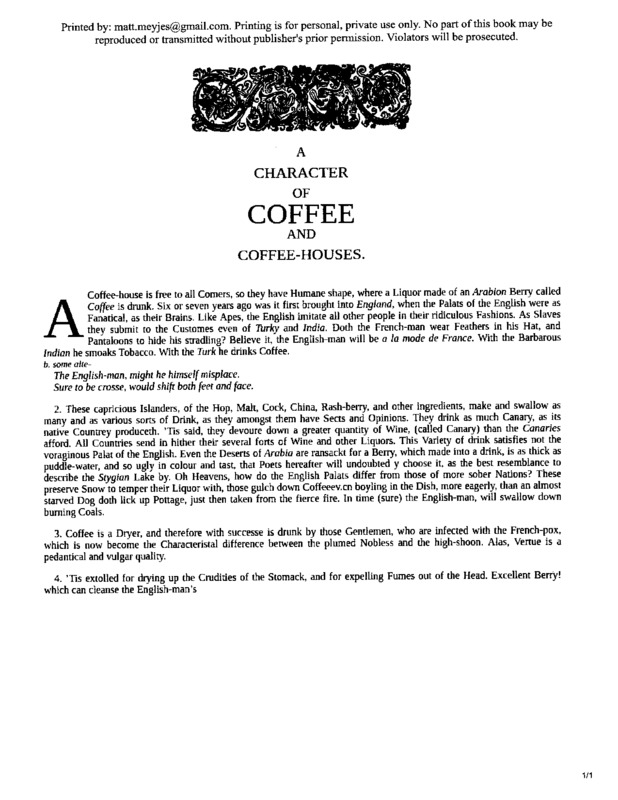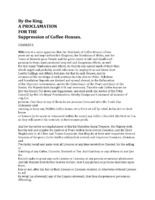Textual Sources on Coffee Houses in England in the late 17th and early 18th Centuries
The pamphlet, A Character of Coffee and Coffee-Houses was published in 1661 by John Starkey in London. The author of the piece is not known, yet goes by the initials M.P, possibly standing for member of parliament. Throughout the ten page pamphlet, the author makes a mockery of Coffee-houses and their inhabitants. John Starkey, the publisher of A Character was an Anabaptist bookseller who had a printing shop near the location of the second known Coffee-house. One of the topics that the author focuses on in the pamphlet is the emasculating effect that Coffee-houses have on men. First, he writes that frequenters have “grown as impotent as Age, as dry and unfruitful, as the Deserts of Africk” (Character 4). While it was common for alehouse patrons to engage in intercourse after their visits, Coffee-house patrons were the opposite, and clearly the author thinks of this as having a negative impact on society (Pincus, 825). He says “In this Age Men tattle more than Women, and particularly at the Coffee-house, when the number hath been but six, five of them have talkt at one time. The Company here have out-talk’d an equal number of Gossipping Women, and made a greater noise than a Bake-house” (Character, 4) By this, the author is accusing of customers of speaking aimlessly, if “six” are present, “five of them have talkt at one time”. He continues to say that a Coffee-house “resembles a School, fill’d with Children, every one conning his Lesson aloud” (Character, 4). Here he insults the manner in which Coffee-house debates go on by comparing it to the way school children speak over one another.
The Character of a Coffee-House, with the Symptomes of a Town-Wit, is a six page pamphlet dated April 11, 1673. The author of this piece is not known. Throughout the pamphlet, the author describes several different people in the Coffee-house, making a mockery of each of them. One man “begins you the story of a Sea-fight; and though he never were further by the water than the Bear-garden. . . he perswades you himself was present” (Ellis, 87). In saying this the author is making fun of Coffee-house frequenters as a bunch of phony know-nothings, who attempt to act wise and knowledgeable. The next man, the town-wit, is described as valuing himself for “understanding the Town” yet really knows “most things in it, that are not worth knowing” (Ellis, 88)
Pamphlets were not the only forum in which anti-coffee sentiment was expressed in society. In 1675, King Charles II issued “A PROCLAMATION FOR THE Suppression of Coffee-Houses”. King Charles, in this proclamation, cited a number of different reasons for why Coffee-houses should be banned. For one, the fact that many tradesmen would “mis-spend much of their time”, sitting around in Coffee-houses, when they should be working. Also, and probably more importantly to the King, the “Defamation of His Majesties Government”. The King worried that the conversations that went on in these Coffee-houses might be dangerous to his power.



